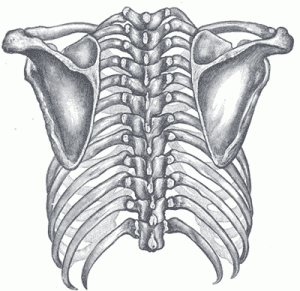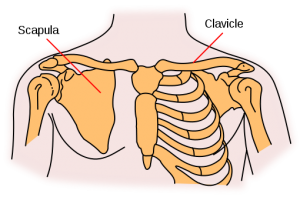The shoulder girdle is four bones, two collar bones (clavicle) and two shoulder blades (scapula). These four bones make up the shoulder girdle as well as the shoulder socket.
The shoulder girdle ideally hangs from the head suspended over the rib cage without either the collar bones or scapula touching the ribs.
The shoulder girdle has only one bony connection to the trunk at the front of the chest— the sternoclavicular joint where the collar bones meet the sternum.
At the back of the body, the shoulder blades are connected by the rhomboid muscles that stretch from the outer edge of the shoulder blade to the spine.
As a result, the shoulder girdle is two pairs of bony units- right scapula and clavicle and left scapula and clavicle— instead of the seemingly stable pelvis.
The shoulder girdle is structurally similar to the pelvis but functionally different.
The mobility of the shoulder girdle allows the arms vs. the weight support function of the pelvis blur their similarities.
Because it is lighter and bound in only one place without firm support the shoulder girdle is more vulnerable to deformation than the pelvis.
And being farther from the ground it offers gravity greater leverage for destruction.
The shoulder is made up of three bones—the collar bone, the shoulder blade, and the humerus, or arm bone.
The direction and quality of arm movements are determined by muscles that form a bridge between the shoulder and humerus.
If the pectoralis major muscle is too tight the head of the humerus will be inwardly rotated.
If the latissimus dorsi is tight the humerus will be rotated externally.
The teres major muscle also has a role in determining the movement potential of the arms.
The shoulder girdle is designed to allow for very free movement of the arm and shoulder because when standing the upper arm is not involved in weight bearing.
As a result, its stability has been sacrificed for a greater range of motion.
While the hip socket is a solid cup for the head of the femur to sit into, the shoulder socket is only a loose structure formed by the acromial and coracoid processes of the shoulder blade.
The arm and shoulder are so loose that a strange thing happens to allow for all of the needed range of motion.
Tendons of certain muscles take on the role of ligaments that would be too strong and tight to enable to ultimate freedom that the shoulder allows.
This section of the arm and shoulder muscles is known as the rotator cuff which I’ll explain in another post.
To a certain degree the shoulder girdle, upper back, and neck form a single movement system. They all reciprocally influence all of the other elements of the body.
***


